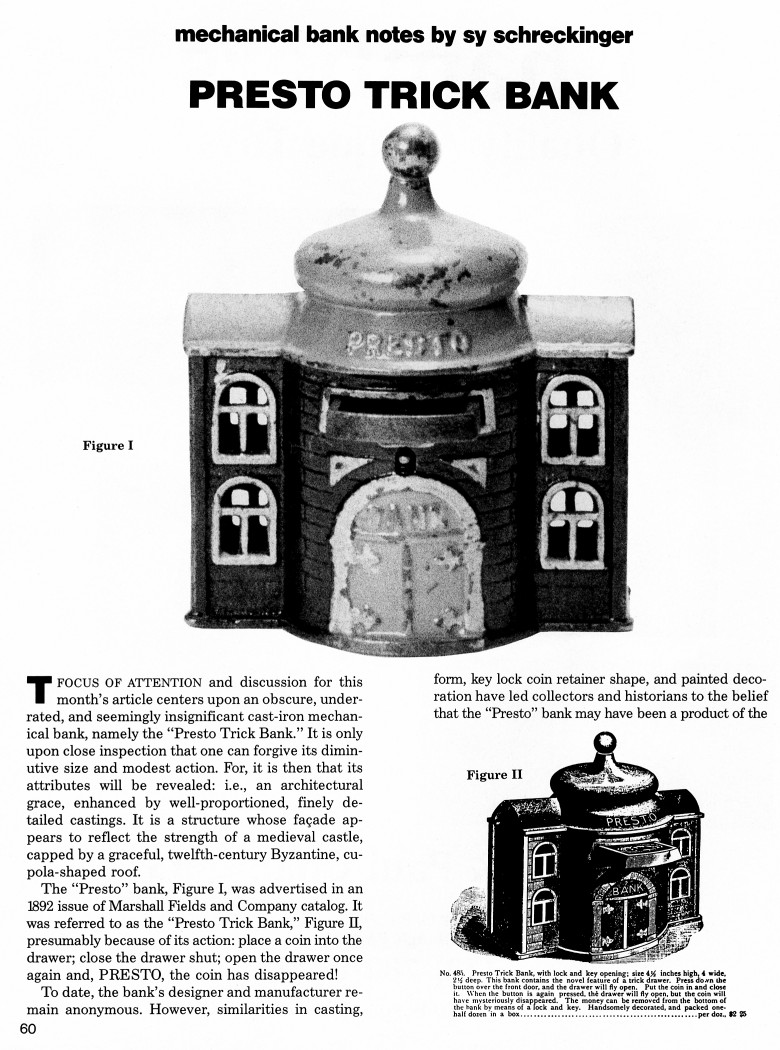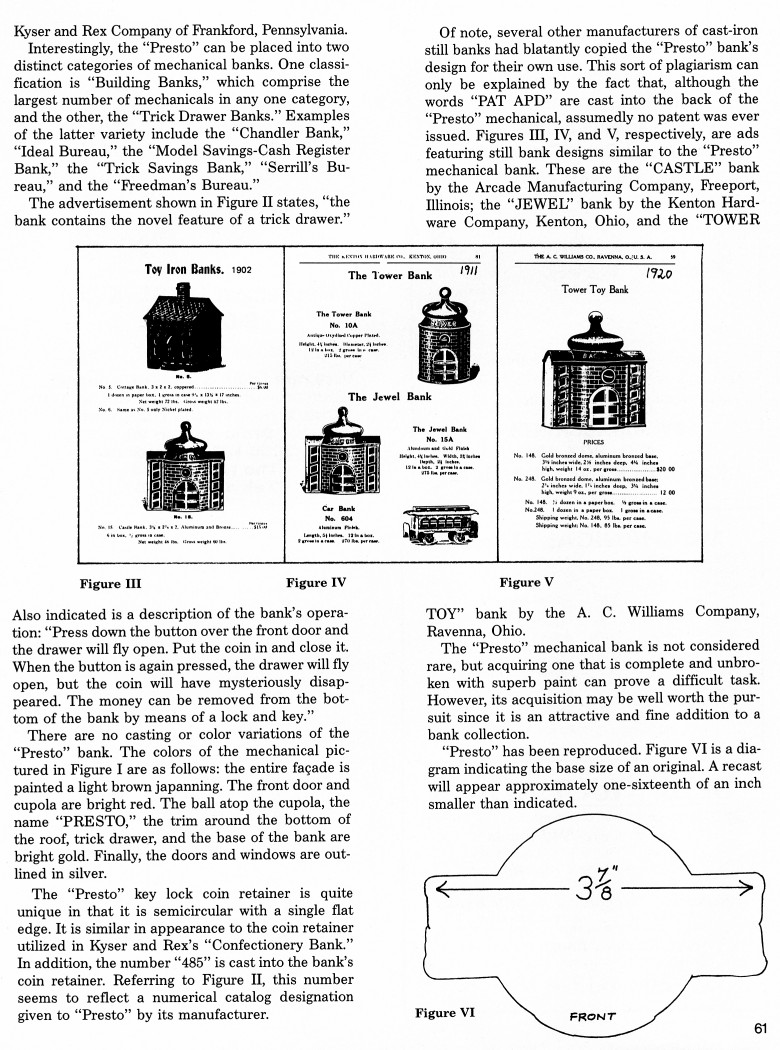|
Presto Trick Bank
by Sy Schreckinger – ANTIQUE TOY WORLD Magazine – April, 1992
The focus of attention and discussion for this
month's article centers upon an obscure, underrated, and seemingly
insignificant cast-iron mechanical bank, namely the "Presto Trick Bank."
It is only upon close inspection that one can forgive its diminutive size
and modest action. For, it is then that its attributes will be revealed:
i.e., an architectural grace, enhanced by well-proportioned, finely
detailed castings. It is a structure whose facade appears to reflect the
strength of a medieval castle, capped by a graceful, twelfth-century
Byzantine, cupola-shaped roof.
The "Presto" bank, Figure 1, was advertised in an 1892 issue of
Marshall Fields and Company catalog. It was referred to as the "Presto
Trick Bank," Figure II, presumably because of its action: place a coin
into the drawer; close the drawer shut; open the drawer once again and,
PRESTO, the coin has disappeared!
To date, the bank's designer and manufacturer remain
anonymous. However, similarities in casting, form, key lock coin retainer
shape, and painted decoration have led collectors and historians to the
belief that the "Presto" bank may have been a product of the Kyser and Rex
Company of Frankford, Pennsylvania.
Interestingly, the "Presto" can be placed into two distinct
categories of mechanical banks. One classification is "Building Banks,"
which comprise the largest number of mechanicals in any one category, and
the other, the "Trick Drawer Banks." Examples of the latter variety
include the "Chandler Bank," "Ideal Bureau," the "Model Savings-Cash
Register Bank," the "Trick Savings Bank," "Serrill's Bureau," and the
"Freedman's Bureau."
The advertisement shown in Figure II states, "the bank contains the
novel feature of a trick drawer." Also indicated is a description of the
bank's operation: "Press down the button over the front door and the
drawer will fly open. Put the coin in and close it. When the button is
again pressed, the drawer will fly open, but the coin will have
mysteriously disappeared. The money can be removed from the bottom of the
bank by means of a lock and key."
There are no casting or color variations of the "Presto" bank. The
colors of the mechanical pictured in Figure I are as follows: the entire
facades is painted a light brown japanning. The front door and cupola are
bright red. The ball atop the cupola, the name "PRESTO," the trim around
the bottom of the roof, trick drawer, and the base of the bank are bright
gold. Finally, the doors and windows are outlined in silver.
The "Presto" key lock coin retainer is quite unique in that it is
semicircular with a single flat edge. It is similar in appearance to the
coin retainer utilized in Kyser and Rex's "Confectionery Bank." In
addition, the number "485" is cast into the bank's coin retainer.
Referring to Figure II, this number seems to reflect a numerical catalog
designation given to "Presto" by its manufacturer.
Of note, several other manufacturers of cast-iron still banks had
blatantly copied the "Presto" bank's design for their own use. This sort
of plagiarism can only be explained by the fact that, although the words
"PAT APD" are cast into the back of the "Presto" mechanical, assumedly no
patent was ever issued. Figures III, IV, and V, respectively, are ads
featuring still bank designs similar to the "Presto" mechanical bank.
These are the "CASTLE" bank by the Arcade Manufacturing Company, Freeport,
Illinois; the "JEWEL" bank by the Kenton Hardware Company, Kenton, Ohio,
and the "TOWER TOY" bank by the A. C. Williams Company, Ravenna, Ohio.
The "Presto" mechanical bank is not considered rare, but acquiring
one that is complete and unbroken with superb paint can prove a difficult
task. However, its acquisition may be well worth the pursuit since it is
an attractive and fine addition to a bank collection.
"Presto" has been reproduced. Figure VI is a diagram indicating the
base size of an original. A recast will appear approximately one-sixteenth
of an inch smaller than indicated.
|


